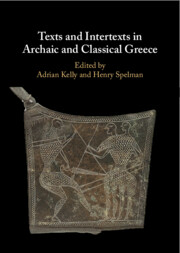Book contents
- Texts and Intertexts in Archaic and Classical Greece
- Texts and Intertexts in Archaic and Classical Greece
- Copyright page
- Contents
- Illustrations
- Tables
- Acknowledgements
- Contributors
- Abbreviations
- Introduction
- Part I Early Intertextuality
- 1 From the Odyssey to the Iliad, and Round (and Round) Again
- 2 The Wisdom of Archilochus
- 3 Intertextual Effects in Early Epigram
- Part II Lyric and Epic
- Part III Drama
- Part IV Conceptual Contexts
- Bibliography
- Index Locorum
- Index Rerum
3 - Intertextual Effects in Early Epigram
from Part I - Early Intertextuality
Published online by Cambridge University Press: 14 November 2024
- Texts and Intertexts in Archaic and Classical Greece
- Texts and Intertexts in Archaic and Classical Greece
- Copyright page
- Contents
- Illustrations
- Tables
- Acknowledgements
- Contributors
- Abbreviations
- Introduction
- Part I Early Intertextuality
- 1 From the Odyssey to the Iliad, and Round (and Round) Again
- 2 The Wisdom of Archilochus
- 3 Intertextual Effects in Early Epigram
- Part II Lyric and Epic
- Part III Drama
- Part IV Conceptual Contexts
- Bibliography
- Index Locorum
- Index Rerum
Summary
Inscribed metrical texts are often marginalised in the study of archaic and classical poetics. This chapter integrates examples from c. 725 to c. 450 BCE with wider practices of intertextuality, where epigrams both share techniques with other kinds of literature and have some distinctive modes of signification. Early epigrams frequently use formulas to demonstrate the adherence of a dedication or funeral to traditional norms. The apparent decline in use of glaukopis on the Acropolis after 550 BCE suggests that these formulas were not just metrically convenient: semantics mattered. Epigrams also replicate formulaic phrases from both elegy and epic with their traditional connotations intact; such connotations enrich our understanding of Phrasicleia’s epitaph (CEG 24), and of ancient epigrammatists’ conceptualisation of the relationship between oral and inscribed poetry. Inscriptions, unlike other texts, also invited interpretation against monuments situated nearby. Early dialogues of this type tend to be cooperative rather than polemical. Examples discussed include Onatas’ signatures at Olympia, the tripods at the Theban Hismenion described by Herodotus, and the relationship of the Eion herms to CEG 2–3.
- Type
- Chapter
- Information
- Texts and Intertexts in Archaic and Classical Greece , pp. 73 - 94Publisher: Cambridge University PressPrint publication year: 2024

